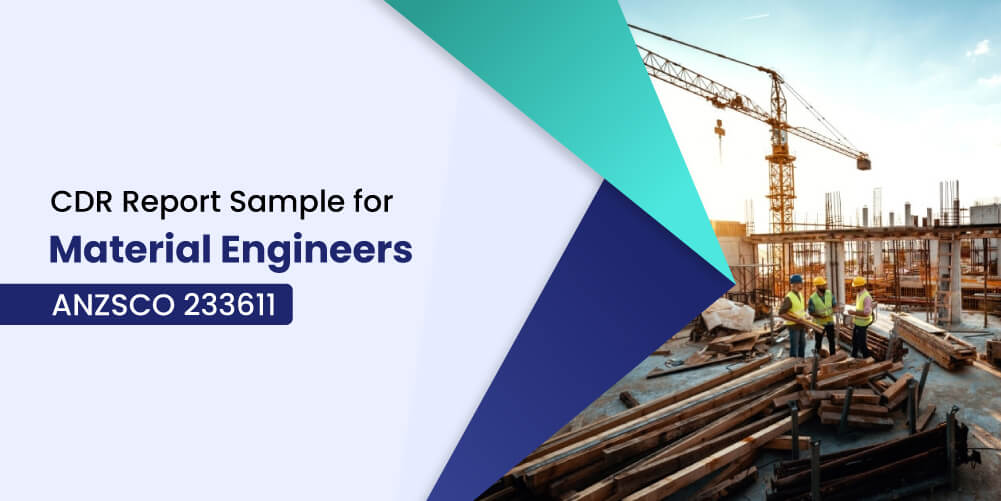MATERIAL ENGINEER ANZSCO 233112
CDR Sample for Materials Engineers

Metals and semiconductors are designed by materials engineers by making a particular mix of chemical, mechanical, and electrical qualities that allow for additional advancements. It is a vital and crucial engineering field.
When it comes to business and job prospects, Australia is becoming a part of a larger global scene. Materials engineers are in great demand in Australia, according to several renowned technical organizations. They are seeking materials engineers with advanced degrees from Australia and other nations.
Australia is looking for qualified individuals in a wide range of fields to help boost its industries around the country. Therefore, competent professionals can get a plethora of chances as well as top average wages in Australia.
The CDR sample for materials engineers includes all required reports such as CV, continuing professional development, career episodes, and a summary statement. CDR samples for migration skills assessment provided by CDRAustraliaHelp are all approved by Engineers Australia. We have a professional team of writers to prepare your CDR report in the best way. The sample content of the CDR report is as follows:
Curriculum Vitae (CV)
Resume on the basis of a professional template.
Continuing Professional Development (CPD)
The sample of CPD clarifies the Engineering Knowledge of the applicant – 350 words.
Materials Engineer Career Episode Sample 1
“The Fabrication and Study of PET/PTT Sheath-Core Monofilaments with Large Diameter Using a Single-Step Coaxial Melt-Spinning” – 1986 words
Materials Engineer Career Episode Sample 2
“Red Light Controllable Liquid-Crystal Soft Actuators via Low-Power Excited Up Conversion Based on Triplet- Triplet Annihilation”– 2588 words
Materials Engineer Career Episode Sample 3
“New Methods for Repairing Line Edge Roughness in Lithography Nano Patterns Using Innovatively Designed Block Copolymer with a High Level of Functionality” – 2230 words
Materials Engineer Summary Statement Sample
Detail explanation of all the competency element – 2246 words.
Materials Engineers Career Episode Sample 1
Project Name: The Fabrication and Study of PET/PTT Sheath-Core Monofilaments with Large Diameter Using a Single-Step Coaxial Melt-Spinning
In the first Career Episode, the candidate explains a project he worked on during his last year of undergraduate studies in Material Science and Engineering.
Her duties included “The Fabrication and Study of PET/PTT Sheath-Core Monofilaments with Large Diameter Using a Single-Step Coaxial Melt-Spinning” and “The Fabrication and Study of PET/PTT Sheath-Core Monofilaments with Large Diameter Using a Single-Step Coaxial Melt-Spinning.”
- Water molecules in supplied PET and PTT polymers are removed.
- Several fundamental characteristics are measured to aid in the testing of cutting and thinning behavior.
- Examines the impact of the core layer’s and coating layer’s extrusion temperatures.
- Analyzes the resulting monofilament material’s different characteristics.
- Special assessment tests on the mechanical characteristics of PET / PTT should be carried out.
Materials Engineers Career Episode Sample 2
Project Name: Red Light Controllable Liquid-Crystal Soft Actuators via Low-Power Excited Up Conversion Based on Triplet- Triplet Annihilation
In second Career Episode, the author explains the engineering skills he used in the project he was involved in for international liquid crystal elastomer conference.
Her duties and responsibilities in the project “Red Light Controllable Liquid-Crystal Soft Actuators via Low-Power Excited up Conversion Based on Triplet- Triplet Annihilation” were:
- Learn more about the many elements of the research, such as azobenzene chromophores’ photoisomerization, polymer crosslinking, soft actuator materials’ behavior before irradiation, and triplet-triplet annihilation.
- To make a cross-linked crystalline polymer film containing azobenzene, multi-stage organic synthesis is used to provide high-purity monomers and cross-linking agents (CLCP).
- Creates and synthesizes a novel up-conversion material system including the killer “9,10BDPPA” and the activator platinum (II) complex “PtTPBP” (fluorescent dye).
- Experiments were conducted to corroborate the notion that PtTPBP and BDPPA would release upconversion, and that the azolidine residues would absorb this release, activating their trans-photoisomerization.
- It’s used to combine PtTPBP and BDPPA into a low-glass-transition-temperature polyurethane, allowing low-power up-conversion luminescence to be fully realized in real-world applications.
- Using the spin coating process, PtTPBP and 9,10BDPPA, which is made up of a crosslinked crystalline polymer film of polyurethane and azoan, are mixed into a transparent adhesive.
- The thermal effect of the 635nm continuous laser on the polymeric substance is recorded using a thermal imaging camera.
Materials Engineers Career Episode Sample 3
Project Name: New Methods for Repairing Line Edge Roughness in Lithography Nano Patterns Using Innovatively Designed Block Copolymer with a High Level of Functionality
The author exhibits the technical abilities he needed to complete the project he was involved in during her bachelor’s degree in Material Science and Engineering in the third Career Episode.
“New Methods for Repairing Line Edge Roughness in Lithography Nano Patterns Using Innovatively Designed Block Copolymer with a High Level of Functionality,” was the title of the project, and his responsibilities included:
- Obtain proper training in occupational safety and health (OSH), particularly in fire safety, before working in the laboratory.
- Investigate the behavior of polymers in aqueous solutions as revealed by a variety of modern material characterization methods.
- Using the live polymerization approach, make a simple poly(4-acetoxy) photopolymer.
- To minimize the edge roughness of lines, engineering block copolymers and polymers are used to treat photoresist patterns.
- To make a so-called neutral substrate, a hydrophobic functional group is added to the exposed substance.
- Prepares OEGMA-based multi-response hydrogels that disperse block polymer water readily and self-assemble into particles less than 10 nanometers in size.
Free Consultation
Our Features
Many clients have received a positive approval. Hurry up and connect with us now!

